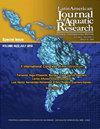Reproductive dynamics of Peprilus medius captured in the Ecuadorian Pacific
IF 0.8
4区 农林科学
Q3 FISHERIES
Latin American Journal of Aquatic Research
Pub Date : 2022-11-01
DOI:10.3856/vol50-issue5-fulltext-2928
引用次数: 0
Abstract
In Ecuador, Peprilus medius is an important fishery resource whose destination is for local consumption and export. There are few local studies on its reproductive biology, and its capture is not regulated. Therefore, this study evaluates the most relevant aspects of its reproductive activity. Samples were obtained monthly from January to December 2017 from the capture of the purse seine fleet and the artisanal gillnet fleet landing near Manta. The morphometric analysis included the length-weight relationship, estimated using the allometry equation. The size at sexual maturity is based on the L50 criterion; the reproductive cycle was determined according to the monthly analyses of the gonadosomatic index (GSI), hepatosomatic index (HSI), and relative condition factor (Kn). A total of 334 specimens were analyzed, with average sizes of 22.0, 21.87, and 21.91 cm of total length (TL), for males, females, and combined sexes, respectively. Sex ratio was 1.17M: 1F (P > 0.05), while the length-weight relationship showed negative allometric growth for both males and females (b = 2.58; CI95% 2.48-2.72). Size at sexual maturity L50 was estimated at 21.84 and 21.23 cm TL for males and females, respectively. The GSI and HSI values and Kn showed significant differences among months (P < 0.05), with a marked seasonality during the single reproductive period. Mean size at first capture of 21 cm TL is recommended.在厄瓜多尔太平洋捕获的中型红毛蚶的繁殖动态
在厄瓜多尔,巴普里乌斯是一种重要的渔业资源,其目的地是当地消费和出口。国内对其生殖生物学的研究较少,对其捕获也不规范。因此,本研究评价了其生殖活动的最相关方面。从2017年1月至12月,每月从在曼塔附近登陆的围网船队和手工刺网船队捕获的样本中获取样本。形态计量学分析包括长度-重量关系,使用异速生长方程估计。性成熟时的大小以L50为标准;根据每月性腺指数(GSI)、肝体指数(HSI)和相对条件因子(Kn)的分析来确定生殖周期。共采集标本334只,雄性、雌性和两性的平均体长分别为22.0、21.87和21.91 cm。性别比为1.17M: 1F (P < 0.05),长重关系为负异速生长(b = 2.58;CI95% 2.48 - -2.72)。雄性和雌性性成熟L50时的大小分别为21.84和21.23 cm TL。GSI、HSI值和Kn在月份间差异显著(P < 0.05),单生殖期具有明显的季节性。第一次捕获的平均大小建议为21厘米TL。
本文章由计算机程序翻译,如有差异,请以英文原文为准。
求助全文
约1分钟内获得全文
求助全文
来源期刊

Latin American Journal of Aquatic Research
FISHERIES-MARINE & FRESHWATER BIOLOGY
CiteScore
1.70
自引率
10.00%
发文量
44
审稿时长
4-8 weeks
期刊介绍:
Latin American Journal of Aquatic Research- LAJAR is the continuation of the journal Investigaciones Marinas (1970-2007) and is published since 2008 by the Escuela de Ciencias del Mar, Facultad de Ciencias del Mar y Geografía of the Pontificia Universidad Católica de Valparaíso. LAJAR is an “Open Access” journal that publishes in English language, original research articles, reviews and short communications on aquatic science, which contain the results of research conducted in aquaculture or in oceanic and coastal marine waters of Latin America.
The following topics are considered: Physical Oceanography, Chemical Oceanography, Marine Biogeochemistry, Marine Pollution and Toxicology, Marine Geology and Geophysics, Biological Oceanography, Fisheries and Aquaculture.
 求助内容:
求助内容: 应助结果提醒方式:
应助结果提醒方式:


